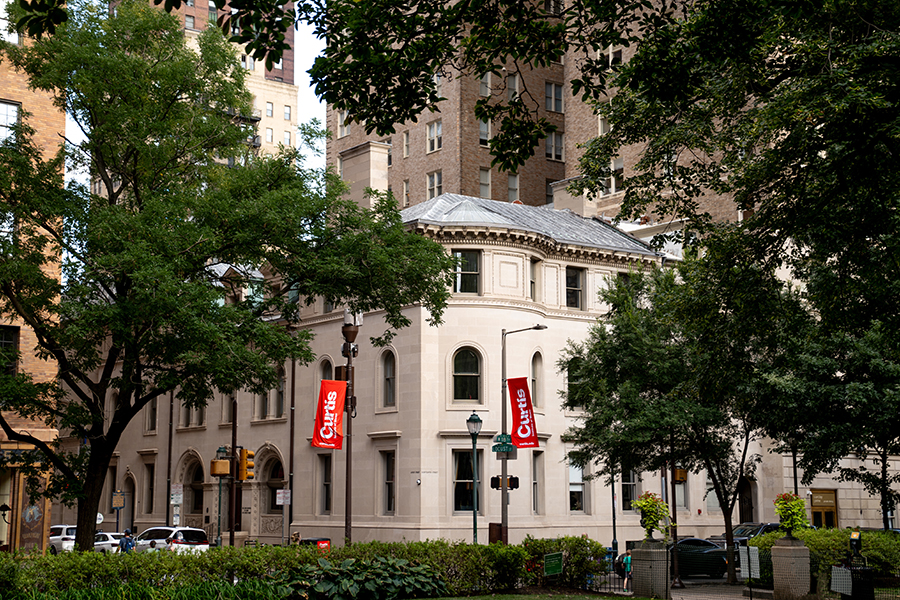This Philly Institute Has Shaped Music for a Century–and Their 100-Year Celebration Is Happening Now

Philadelphia has never been shy about its artistic legacy. From world-class museums to a thriving theater scene, the city has long been a hub for creativity. But while many may claim a love for the arts in Philadelphia, fewer may realize just how deeply Philadelphia has shaped the course of classical music.
That impact is thanks to the Curtis Institute of Music, an institution that, for the past century, has trained and launched some of the most influential musicians and composers in the world, all right on Rittenhouse Square. Founded in 1924, Curtis’ alumni list reads like a who’s who of 20th- and 21st-century music: Leonard Bernstein, Samuel Barber, Jennifer Higdon, George Walker, and a host of other composers and performers who have left their mark on orchestras, opera houses, and concert halls across the globe. The school’s impact extends far beyond its Philadelphia campus, influencing the evolution of composition, performance, and the teaching of music.
The school also regularly engages with the Philadelphia community, through performances on their campus and at beloved Philly venues like the Kimmel Center, as well as online. And if you’ve never interacted with the school before, now is the year to do it. Curtis is celebrating its 100th anniversary, and it’s marking the occasion with not only a slate of performances honoring the school’s legacy, but its sweeping 100 for 100 project, an initiative that commissioned 100 new works in recognition of the school’s 100th anniversary and its historic role in supporting the arts.
The completion of the project presents a good opportunity to review Philly’s impact on musical history, and a chance to see how that impact continues to evolve today. So, if you’re interested in learning about Philly’s musical history through the people and the performances that defined it, here’s what you need to know.

Exterior of the Curtis Institute on Rittenhouse Square, photo by Margo Reed.
The Legacy of Curtis
Since its founding, Curtis has operated on the principle that exceptional talent deserves uncompromising training, with an elite, tuition-free model that produces some of the most celebrated composers and performers in classical music.
That includes iconic figures like Leonard Bernstein, one of Curtis’ most renowned alumni and perhaps one of the best-known figures in 20th-century classical music. A conductor, composer, and educator, Bernstein left an indelible mark on both the classical music world and the Curtis legacy. His work, particularly his operetta Candide, which will be performed by Curtis Opera Theatre during the centennial celebrations, exemplifies his ability to synthesize musical brilliance with cultural impact. As a Curtis student in the early 1940s, Bernstein’s groundbreaking achievements came to fruition thanks to the rigorous training and artistic freedom Curtis provided.

(Left) Faculty Randall Thompson with students (in alphabetical order): Leonard Bernstein, Waldemar Dabrowski, Annette Elkanova, Albert Falcove, Hershy Kay, Leo Luskin, and Constant Vauclain (Andre). (Right) Gian Carlo Menotti, Samuel Barber, and Gama Gilbert outside of Curtis in 1930s.
He joins a number of legendary alumni, including Samuel Barber, one of the most celebrated American composers of the 20th century, known worldwide for Adagio for Strings. But Curtis has also been a place where composers have pushed musical boundaries and broken cultural barriers. George Walker’s legacy as the first African-American composer to win the Pulitzer Prize for Music speaks to the school’s role in amplifying diverse voices. Musically, Gian Carlo Menotti brought opera to broader audiences, crafting narratives that resonated far beyond traditional opera houses, and Julius Eastman, known for his experimental approach and social activism, pushed the limits of minimalism. In contemporary music, the work of alumni Ned Rorem, who helped define the American art song, and Jennifer Higdon, whose Pulitzer-winning works are expanding the repertoire, are still making an impact today.
The centennial celebration is inspired by figures like these, and their music shows how they, and in turn, Philadelphia, are part of a living, evolving tradition. If you want to hear that legacy, Curtis Studio has released A Century of New Sounds, an album featuring works by Curtis legends like Barber, Bernstein, and Higdon, performed by ensembles such as Imani Winds and the Dover Quartet. Live performances throughout the centennial will also frequently hearken back to the school’s long legacy.
The 100 for 100 Project
But to get started, the 100 for 100 project is easy to check out–it’s a free, online showcase that features commissions from a new generation of composers, many of whom are Curtis alumni. If you’ve never quite known how to find your way into contemporary classical music, the project makes it easy, highlighting the leading lights and rising stars of today, including notable composers like TJ Cole, Sebastian Chang, Rene Orth, James Ra, Dai Wei, Alyssa Weinberg and more.
The commissions show how contemporary classical music is broader than many people may realize. For example, Paul Brantley’s Cardinal Sonatina draws inspiration from Malagasy tunes and the Spanish duende, showcasing the integration of diverse musical influences into his compositions, while Katerina Souponetsky’s works, including the newly commissioned Amethyst, blend introspective rhythms with jazz-inflected textures.
It can also be a lot of fun, from Chia-Yu Hsu’s organ performance in A Bright Celebration to Yevgeniy Sharlat’s DADA-Jam to the many electronic and experimental works throughout the project. And reflecting Curtis’ Philly spirit, the series features many local ties, including a composition celebrating Rittenhouse Square, works by young composers who have become a part of Philly’s artistic and literary community, and former students of Rorem–as well as Higdon herself.
So, whether through the upcoming performance of Candide, the exploration of the latest 100 for 100 commissions, or one of the free recitals each week, there’s no better time to get to know the city’s musical evolution and feel your own connection to musical history. It’s not just a chance to look into its past, but its future as well.
This is a paid partnership between Curtis Institute of Music and Philadelphia Magazine